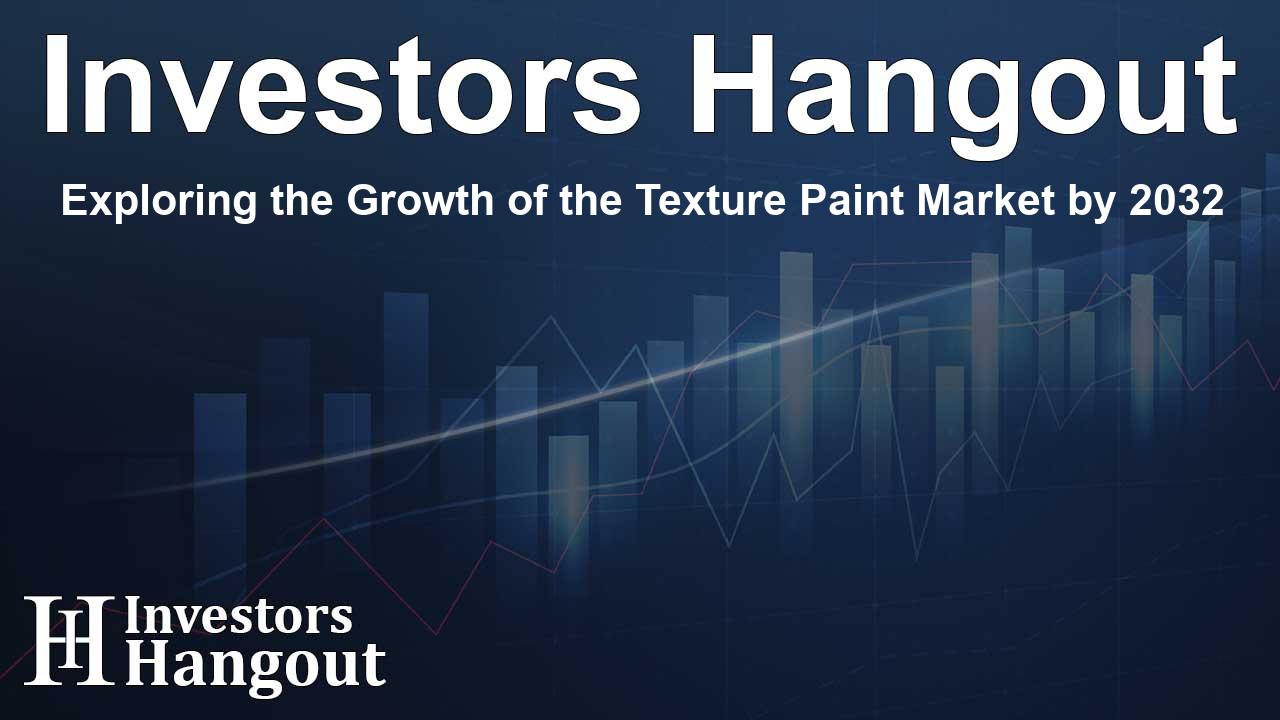Exploring the Growth of the Texture Paint Market by 2032

Texture Paint Market Overview
The global texture paint market is on the verge of significant expansion, with projections indicating a remarkable revenue of USD 18.47 billion by 2032. This growth is fueled by an anticipated compound annual growth rate (CAGR) of 4.43% in the period extending from 2024 to 2032. The demand for texture paints has seen a surge, largely attributed to advancements in sustainability and digital innovation.
Driving Forces Behind Market Growth
Texture paints find immense application across both new constructions and renovation projects, serving not just aesthetic purposes but also offering practical benefits. These paints adeptly cover surface flaws while providing elegant finishes that align with contemporary urban designs. One notable trend is the shift towards low-VOC and environmentally friendly ingredients that support stringent green building certifications and regulations. Increasing global awareness about sustainability is stimulating demand for such innovative paint solutions.
Impact of Construction Activities
Another factor contributing to the heightened demand for texture paints is the robust growth of construction activities, especially in emerging global economies. As urbanization progresses, the associated rise in both commercial and residential development is becoming apparent. Companies are adapting to these evolving demands by introducing advanced technologies—ranging from silica-based textures to enhanced spray techniques—enabling them to meet consumer needs more effectively.
Regional Insights: The US Market Leads
As of 2023, the U.S. dominated the global texture paint market, posting a valuation of USD 1.71 billion. Analysts forecast this figure will escalate to USD 2.73 billion by the year 2032, growing at a CAGR of 5.34%. The U.S. market benefits from its established renovation and construction sectors, paired with an increasing consumer preference for high-quality interior designs.
Technological Innovations and Key Players
Technological advancements contribute significantly to the market's landscape, with influential players like Sherwin-Williams, PPG Industries, and Benjamin Moore emerging as trailblazers in launching innovative textures and finishes. Various initiatives from the government aimed at retrofitting existing infrastructure with energy-efficient coatings are also playing a crucial role in boosting demand.
Market Segmentation Analysis
In terms of market segmentation, texture paints are categorized by types such as smooth and sand textures. A standout segment, sand-textured paints commanded approximately 50.3% of the market share in 2023. The appeal of these paints stems from their durability and versatility, rendering them ideal for high-traffic commercial areas. Furthermore, this segment is recognized for its weather resistance and lower maintenance needs.
Technology Trends in Texture Paints
The technological advancements in texture paints depict a clear preference for water-based formulations. This sector accounted for a substantial 63.2% market share in 2023, with projections indicating its continued dominance due to regulations aimed at reducing harmful emissions. Water-based paints not only align with environmental guidelines but also present a quicker drying time, further enhancing their popularity.
Future Developments and Sustainability
Residential markets also show significant potential, as texture paints account for about 55.7% of the segment in 2023. The ongoing trend of home beautification and renovation has heightened the demand for textured finishes that add character to home interiors. The introduction of environmentally friendly paints that cater to the growing concerns over sustainability is also shaping consumer preferences.
Recent Market Developments
- Asian Paints introduced a new line of eco-friendly texture paints in 2023, integrating natural stone particles with zero-VOC formulations tailored to environmental standards.
- Sherwin-Williams launched its "Texture Pro" line in 2024, focusing on customized wall coatings employing cutting-edge spray technologies.
- Nippon Paint opened a state-of-the-art R&D facility in Singapore focused on bio-based and nano-textured paint formulations designed for tropical climates.
Frequently Asked Questions
What is the projected size of the texture paint market by 2032?
The texture paint market is projected to reach USD 18.47 billion by 2032.
What are the primary drivers of growth in the texture paint market?
The key drivers include increasing demand for sustainable solutions and booming construction activities globally.
Which region currently dominates the texture paint market?
As of 2023, the United States holds the largest share of the texture paint market.
What types of texture paints are most popular?
Sand-textured paints are the most popular, representing a significant share of the market due to their durability and visual appeal.
How is technology influencing the texture paint industry?
Technology is driving innovation in product formulations, such as the move towards water-based paints that are less harmful to the environment.
About The Author
Contact Evelyn Baker privately here. Or send an email with ATTN: Evelyn Baker as the subject to contact@investorshangout.com.
About Investors Hangout
Investors Hangout is a leading online stock forum for financial discussion and learning, offering a wide range of free tools and resources. It draws in traders of all levels, who exchange market knowledge, investigate trading tactics, and keep an eye on industry developments in real time. Featuring financial articles, stock message boards, quotes, charts, company profiles, and live news updates. Through cooperative learning and a wealth of informational resources, it helps users from novices creating their first portfolios to experts honing their techniques. Join Investors Hangout today: https://investorshangout.com/
The content of this article is based on factual, publicly available information and does not represent legal, financial, or investment advice. Investors Hangout does not offer financial advice, and the author is not a licensed financial advisor. Consult a qualified advisor before making any financial or investment decisions based on this article. This article should not be considered advice to purchase, sell, or hold any securities or other investments. If any of the material provided here is inaccurate, please contact us for corrections.
